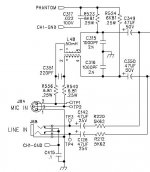Sir Trefor said:
Do you mean 6 to 8k..., or... 6k?
In every application I have ever seen, Phantom power is supplied through precision matched 6.8K resistors. (6.81K is the value I've seen in catalogs -- the important thing is that they are matched to each other so that there is no DC imbalance between + and -)
I believe the caps moamps is referring to are the .1µ caps shown in the balanced XLR part of the schematic, which block the DC from entering the preamp. Depending on the input circuitry of your preamp, they may or may not be needed. Some input transformers can handle the DC -- as Per Lundahl pointed out to me once, "What is important is the NET voltage at the transformer primaries. With perfectly matched phantom resistors, the net voltage will be zero."
Then there's the old Telefunken trick: Use a DPDT switch for the phantom. One pole energizes the phantom resistors, while the other pole inserts a 10µ cap in between the primaries of the input transformer. (Only works if the input transformer has two sets of primaries connected in series.) When the phantom power of off, a wire shorts out the 10µ cap, taking it completely out of circuit.
If the input circuitry isn't exactly known or easily traceable, I'd say stick with the blocking caps to be safe. I do agree with moamps that they should be a higher value, though, and they should be good quality! (They're right at the beginning of the signal path!)
Hope this helps,
-E.
the noobie speaks...
hate to sound like the rookie that I am... but what is NFB?Geek said:
the 12AX7 is an excellent tube. Using both sections will give you plenty of gain, but without NFB, will be noisier than a single high-gain pentode.
sadness...
Alright, I've got my phantom power box nearly finished(I will post pictures when I am done). But, now it appears that my mic pre and mixer projects have just gotten a little more important----
Both of my Behringer mixers, along with my Sennheiser microphone, and all of my cables were stolen out of the trunk of my car. I now have nothing to record with. I need a 4 channel mixer with a mono output, and a 4 channel mic pre with a mono output.
Alright, I've got my phantom power box nearly finished(I will post pictures when I am done). But, now it appears that my mic pre and mixer projects have just gotten a little more important----
Both of my Behringer mixers, along with my Sennheiser microphone, and all of my cables were stolen out of the trunk of my car. I now have nothing to record with. I need a 4 channel mixer with a mono output, and a 4 channel mic pre with a mono output.
Re: sadness...
Oh man... that's terrible!!!
If I were you I'd get something like this.
Sir Trefor said:I need a 4 channel mixer with a mono output, and a 4 channel mic pre with a mono output.
Oh man... that's terrible!!!
If I were you I'd get something like this.
Looks like something I could really use... Does anyone have any detailed information on it? I googled it and came up with about 1000 web pages that only popped up because the word "Altec" was mentioned on the page once, or something--- you know how it goes.
-Trevor
:edit: I also tried searching for a manuel of it on ebay- I found none. Can I get a reprint manuel somewhere?
-Trevor
:edit: I also tried searching for a manuel of it on ebay- I found none. Can I get a reprint manuel somewhere?
Everything is fine
Ok, so I am currently bidding on the aforementioned Altec 1567 preamp/mixer.
I am also working on my phantom box, but I just realized something--- as I study the schematic I notice that the capacitors at the beginning of the voltage source(220 uF) are polarized. Why do they need to be polarized?
-Trevor
Ok, so I am currently bidding on the aforementioned Altec 1567 preamp/mixer.
I am also working on my phantom box, but I just realized something--- as I study the schematic I notice that the capacitors at the beginning of the voltage source(220 uF) are polarized. Why do they need to be polarized?
-Trevor
Ghost power
Finally got my picture hosted so you guys can see it- phantom power injector .
As you can see I used no circuit board.
This is what my "desk" (or "cardtable" ) looked like after completing it-
) looked like after completing it-
click the link!
Like mentioned earlier, all my equipment was stolen briefly after I finished this, so I haven't tried it yet.
Oh, yeah... and I used essex magnet wire to connect everything inside.
Finally got my picture hosted so you guys can see it- phantom power injector .
As you can see I used no circuit board.
This is what my "desk" (or "cardtable"
click the link!
Like mentioned earlier, all my equipment was stolen briefly after I finished this, so I haven't tried it yet.
Oh, yeah... and I used essex magnet wire to connect everything inside.
- Status
- This old topic is closed. If you want to reopen this topic, contact a moderator using the "Report Post" button.
- Home
- Amplifiers
- Tubes / Valves
- Tube mic preamp/mixer
